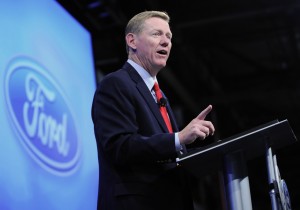
Ford CEO Alan Mulally's One Ford strategy is yielding results - but he and Ford's products will be tested in the months to come.
Intent on showing last year’s positive numbers weren’t a fluke, Ford Motor Co. weighed in with another solid earnings report, this time going $2.08 billion into the black for the first quarter of 2010.
The profit, which amounted to 50 cents a share, comes as a striking turnaround from the same period in 2009, when Ford reported a $1.43 billion loss, equal to a deficit of 60 cents a share. More significantly, the 2010 figures come in at more than double the $1 billion – or 31 cents a share – the consensus of industry analysts surveyed by Thomson One Analytics had predicted.
The latest numbers give hope to observers who are waiting to see if Ford can weigh in with another full-year profit. Net income for 2009 came to $2.7 billion – the first time the maker had been in the black for a full year since 2005.
The automaker expects to be “solidly profitable” for the current year as a whole, declared Chief Financial Officer Lewis Booth.
To further back up that projection, the typically cautious maker now plans to produce 625,000 cars, trucks and crossovers at its North American plants during the second quarter, a more than 5% increase from the original 595,000 vehicles scheduled to roll down Ford assembly lines.
The latest numbers were, in turn, the best first-quarter performance for Ford in six years, reflecting not just the maker’s improved sales — which have been benefiting from the overall improvement in the American auto market – but a steady increase in transaction prices and margins.
Notably, Ford achieved a $1.2 billion profit in the long-struggling North American market, a major turnaround from the $665 million loss during the first quarter of 2009. It also gained nearly three points of market share, company officials reported during a conference call with reporters, to 16.6%. Focusing solely on the retail side of the business, Ford took a 14.1% share during the quarter.
“It’s absolutely on the strength of our product,” said CEO Alan Mulally, adding, “We anticipate growing the business going forward.”
That’s not limited to the American market, however. The company’s new Fiesta has lately been the top-selling product in Europe, where Ford also reported significant sales gains for the quarter and was, for the month of March, the largest brand in the Continent’s 19 key markets.
Add to Europe the maker’s strong performance in South American and other markets, and the strong numbers turned in by the captive finance subsidiary Ford Motor Credit Co.
The Fiesta is a cornerstone of Ford CEO Alan Mulally’s so-called One Ford strategy. The goal is to fully integrate all the maker’s various regions. Among other things, that will result in products that can be developed in one market, say Europe, and then sold around the world with only minimal modifications. The American version of the Fiesta shares about 90% of its components with those of the European subcompact.
There are some potential downsides, despite Ford’s good first quarter. One reason for its strong performance was Mulally’s decision to hold back on profit-gobbling incentives. But, cautioned analyst Joe Phillippi, of AutoTrends Consulting, that meant accepting that Ford will lose some sales and share to Toyota, which is using cash giveaways to overcome the impact of its ongoing safety scandal. Toyota nudged past Ford to become the U.S. market’s second-largest automaker, last month, and is on course to potentially take the lead away from General Motors in April.
Going forward, Ford’s steady push into passenger cars, and especially small models like Fiesta and Focus, put it at risk if American buyers don’t keep downsizing.
And then there’s the issue of Ford’s debt, at $34.3 billion largely accrued prior to the recession when CEO Mulally mortgaged the company’s assets to position it for a possible downturn. That helped Ford avoid the fate of GM and Chrysler, both surviving only through bankruptcy and bailout, but it does add to Ford’s ongoing operating costs.
Mulally recently told TheDetroitBureau.com he intends to continue taking steps to draw down that debt, through equity swaps and other measures. But he also stressed Ford intends to preserve its so-called “revolver,” as a caution against further economic downturns.
How much more will Ford earn this year? Don’t use the first-quarter numbers as a template, cautioned Booth, saying, “It would be unwise to think of the $2 billion as a running rate for the year.”
Joe Szczesny contributed to this report.
